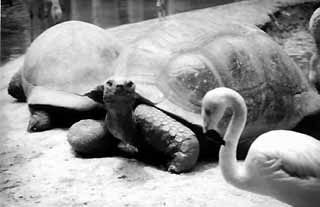Day Trips
By Gerald E. McLeod, Fri., June 30, 2000

The San Antonio Zoo takes visitors on a safari around the world to visit rare Sumatran tigers, African white rhinos, and elusive snakes from the Mexican jungles. The screams of a distant parrot mixes with the laughter of a group of monkeys as the cacophony bounces off the limestone cliffs to settle into the cool shade of the river forest.
The San Antonio River runs through the exhibits giving this zoo a life that no pseudo-stream can re-create. Flower beds along the paved trails display an astonishing array of plants and blooms. The thick jungle of native pecan, live oak, and cypress trees are older than the park that was founded in 1914. Operated by the nonprofit San Antonio Zoological in an abandoned quarry owned by the city, this is an open-air classroom full of sights and sounds.
"Education is a huge part of our mission," says Jordan Jay, spokesperson for the zoo. "If we can get people to relate to the animals, maybe we can get them to help save the vanishing species." The zoo has 3,500 animals representing more than 750 species, and many of them are on the endangered list.
Without the help of zoos, many of the species might disappear within a generation. The San Antonio Zoo has been a world leader in breeding programs, Jay says. The baby white rhino born in 1972 proved that American zoos could have an impact on dwindling herds. It was only the second zoo birth for a white rhinoceros in the world and the first in the U.S. Since then, six more of the African beasts have become Texas natives. Today, the animals, the size of a midsized car, seem oblivious to their place of honor as curious eyes stare down in amazement at their mud-caked armor hides.
Two rare Sumatran tiger cubs born earlier this year are another example of the San Antonio park's world leadership in preserving endangered species. With only 350 to 500 of the animals left in the world, the successful breeding program had a major impact on the survival of the species. As a participant in the American Zoological Association's (AZA) Species Survival Plan, the Texas zoo received the tiger cubs' mother from the San Diego Zoo and the father from Rotterdam.
Not only has the overall look of the zoo changed drastically over the last 86 years, but so has the philosophy behind the scenes. "Zoos are really evolving," Jay says. "It used to be a zoo wanted one of each kind of animal. Now we'd rather have family groups." Animals are no longer bred simply to have cute little babies to attract visitors. "We can't breed an animal without AZA's approval," Jay says. The goal is to produce a captive population with a healthy gene pool.
Also, the care of the animals has changed. What used to be the zoo's nursery center where newborns were kept is now the Conservation Research Center. Instead of being separated, the babies and mother are kept together whenever possible. "We had the tiger cubs for four months before they had any contact with people," Jay says. Too much human contact at birth can cause problems that may not become apparent for several generations.
As much as possible, the animals' enclosures are as attractive and home-like as the zoo can make them. The original part of the zoo is the bear enclosures cut out of the same limestone cliff that was possibly used for building materials for the Alamo a few miles to the southeast. Gone is Mopie, the handsome gorilla that was the zoo's "official greeter" for 16 years until he was returned to his original home in the National Zoo in Washington, D.C.
Next to the bears are the Kodo dragons in an area where they can blend into the tall grass. Marci, a reticulated python, lounges in the cool shade nearby. As big around as a basketball and 25 feet long, she became the longest python in America when a cousin at the Bronx Zoo had surgery that lopped off a few feet.
The pathways fan out through the Amazon River Forest, African Plains, Rift Valley Trail, Australian Walkabout, the Wetlands, and the children's Fun Farm area. Besides the herpetarium, special indoor exhibits include the Friedrich Aquarium and the Hixon Bird House with 14 glass-enclosed areas with rare and colorful birds.
A day at the zoo can be a special occasion, especially when you realize that it is part wildlife preserve and botanical garden. There are plenty of cool places to escape the summer warmth as you make your journey around the world in 35 acres. Opening on June 30 is a new exhibit featuring three kinds of endangered cranes including the whooping cranes. Soon to be added will be Fox and Fiddle, a father and son pair of Asian otters who will compete for visitors' attention with the popular seals.
The San Antonio Zoological Garden and Aquarium opens every day of the year at 9am and closes at 6pm in the summer and 5pm in the winter. Of course the animals are most active in the cooler months, but one of the best bargains is the family membership. For $55 a year two adults and up to eight children receive free admission for 12 months. The membership includes concession discounts, a zoo magazine, sneak previews to new exhibits, and, best of all, entrance to the zoo during breakfast, when the animals are most active.
Regular zoo admission is adults $7, seniors $5, children three to 11 years old $5, and free for three years old and under. For more information, call 210/734-7184 or www.sazoo-aq.org. For information on AZA's Species Survival Plan go to www.aza.org.
Coming up this weekend ...
Half Moon Holidays in Shiner starts the nation's birthday early with an old-fashioned party in Green-Dickson Park, July 1. 361/594-4180.
Aqua-boom Celebration in Kingsland combines water sports, music, and land-based fun, July 1-4. 915/388-6211.
Coming up ...
Bluegrass Festival in Overton presents Grand Ole Opry stars and rising stars plus music workshops, and camping, July 7-8. 903/834-3171 or www.ci.overton.tx.us.
Taste of Dallas in the West End District offers samples from area restaurants plus non-stop entertainment, July 7-9. 214/741-7185 or www.dallaswestend.org.








